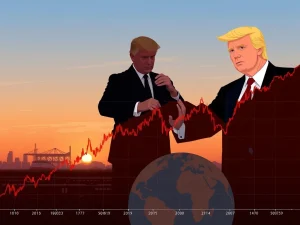Stablecoins’ Unstoppable Bull Market: Solana’s Struggle Amid Crypto Jitters

Navigating the choppy waters of the cryptocurrency market can be daunting. While Bitcoin and Ethereum often steal the spotlight, a quieter revolution is brewing within the realm of stablecoins. Amidst market-wide uncertainties that are causing ripples for major players like Solana and Ethereum, stablecoins are demonstrating remarkable resilience, even entering what analysts are calling a ‘bull market.’ Let’s dive into VanEck’s latest insights to understand this intriguing divergence and what it means for the future of Web3.
Why Stablecoins Are Defying Crypto Market Sentiment
In a recent monthly note, asset management giant VanEck highlighted a fascinating trend: stablecoins are not just weathering the storm of negative crypto market sentiment; they are thriving. This is happening even as smart contract platforms like Ethereum and Solana experience a slowdown. Why this decoupling? Several factors are at play:
- Macroeconomic Uncertainty: Global economic jitters, fueled by events like potential trade wars and tariff policies, are pushing investors towards the perceived safety of stablecoins. These digital assets, pegged to fiat currencies like the US dollar, offer a haven in volatile times.
- Strategic Case for Crypto: Uncertainty can ironically strengthen the appeal of cryptocurrencies as alternative assets. Stablecoins, in particular, become attractive as a stable entry and exit point within the crypto ecosystem.
- Tokenized Treasury Bills: The rise of tokenized treasury bills is a significant tailwind for stablecoin adoption. These instruments provide a source of yield and further legitimize the use case of stablecoins, especially for institutional investors.
As Matthew Sigel, VanEck’s head of research, pointed out, macroeconomic headwinds might just be the unexpected catalyst accelerating crypto’s strategic importance, with stablecoins at the forefront of this surge.
The Explosive Growth of Stablecoins: A Bull Market in Numbers
The numbers speak volumes about the stablecoin bull market. Consider these key data points from VanEck’s report:
- $10 Billion Inflow: In March alone, stablecoins collectively saw their market capitalization jump by nearly $10 billion. This is a substantial influx, indicating strong and growing demand.
- Persistent Inflows Despite Yield Drops: Interestingly, this growth occurred even as average stablecoin yields decreased significantly, from as high as 10% at the start of the year to the 3%-5% range, aligning closer to traditional Treasury Bills. This suggests that investors are valuing stability and safety over high yields in the current climate.
- Tokenized Treasury Bill Surge: Supporting this narrative, the issuance of tokenized Treasury Bills witnessed a powerful 26% increase from February to March, exceeding $5 billion in total issuance. This underscores the institutional interest in stablecoins and related yield-generating opportunities.
These figures paint a clear picture: the stablecoin market is not just resilient; it’s expanding rapidly, driven by a flight to safety and the increasing sophistication of the crypto market.
Solana’s Sputtering Performance: What’s Weighing it Down?
While stablecoins are basking in a bull market, the story is different for some smart contract platforms, notably Solana. VanEck’s report highlights a concerning slowdown for Solana:
- Revenue and Volume Plunge: Smart contract platforms overall experienced a downturn, with revenues and trading volumes declining by 36% and 40%, respectively.
- Solana’s Sharper Decline: Solana felt this impact more acutely. Its daily fee revenues plummeted by a staggering 66%, and decentralized exchange (DEX) volumes shrank by 53% in March.
- Losing Ground to Ethereum: After briefly outperforming Ethereum and its Layer-2 solutions (L2s) in DEX volume in February, Solana has once again fallen behind. This reversal signals a shift in trader preference and platform activity.
What’s behind Solana’s struggle? VanEck points to a key factor: the cooling off of memecoin trading.
The Memecoin Effect on Solana
Memecoins have been a significant driver of activity on Solana’s DEXs. However, this segment has been hit hard by recent scandals and soured market sentiment. Notable events include:
- Libra Memecoin Debacle: The launch and rapid collapse of Libra, a memecoin linked to Argentine President Javier Milei, erased billions in market cap within hours, shaking trader confidence.
- Broader Memecoin Fatigue: Beyond specific scandals, a general fatigue and risk aversion seem to be setting in among retail traders regarding memecoins, impacting platforms heavily reliant on this trading activity like Solana.
While Ethereum’s L2s also saw a decrease in trading volumes (around 18%), they demonstrated greater resilience than Solana, indicating a potentially more diversified and robust ecosystem.
Web3 Adoption: Stablecoins as a Health Indicator
Despite the fluctuations in smart contract platform activity, the continued adoption of stablecoins is a positive sign for the overall health of Web3 adoption. Stablecoin adoption serves as a crucial metric for gauging the underlying growth and utility within the decentralized web.
- Real-World Use Cases: The increasing use of stablecoins in real-world applications, from remittances to payments and DeFi protocols, demonstrates their growing utility beyond just trading instruments.
- Institutional On-ramps: The rise of tokenized treasury bills and institutional interest in stablecoins signals a maturing market and broader acceptance of crypto assets within traditional finance.
While the crypto market will undoubtedly continue to experience ups and downs, the enduring strength of stablecoins suggests a solid foundation for future growth and Web3 adoption.
Conclusion: Navigating the Divergent Paths of Stablecoins and Smart Contract Platforms
The crypto market is currently presenting a tale of two cities. On one hand, stablecoins are experiencing an undeniable bull market, fueled by macroeconomic uncertainties and a growing demand for stable digital assets. On the other hand, platforms like Solana are facing headwinds, grappling with reduced activity and shifting market sentiment, particularly in the memecoin space.
VanEck’s analysis underscores the dynamic nature of the crypto landscape. While short-term volatility is inevitable, the persistent growth of stablecoins offers a beacon of optimism, suggesting a maturing market and a robust foundation for the continued evolution of Web3. Investors and enthusiasts should closely monitor these diverging trends to navigate the evolving crypto narrative effectively.








